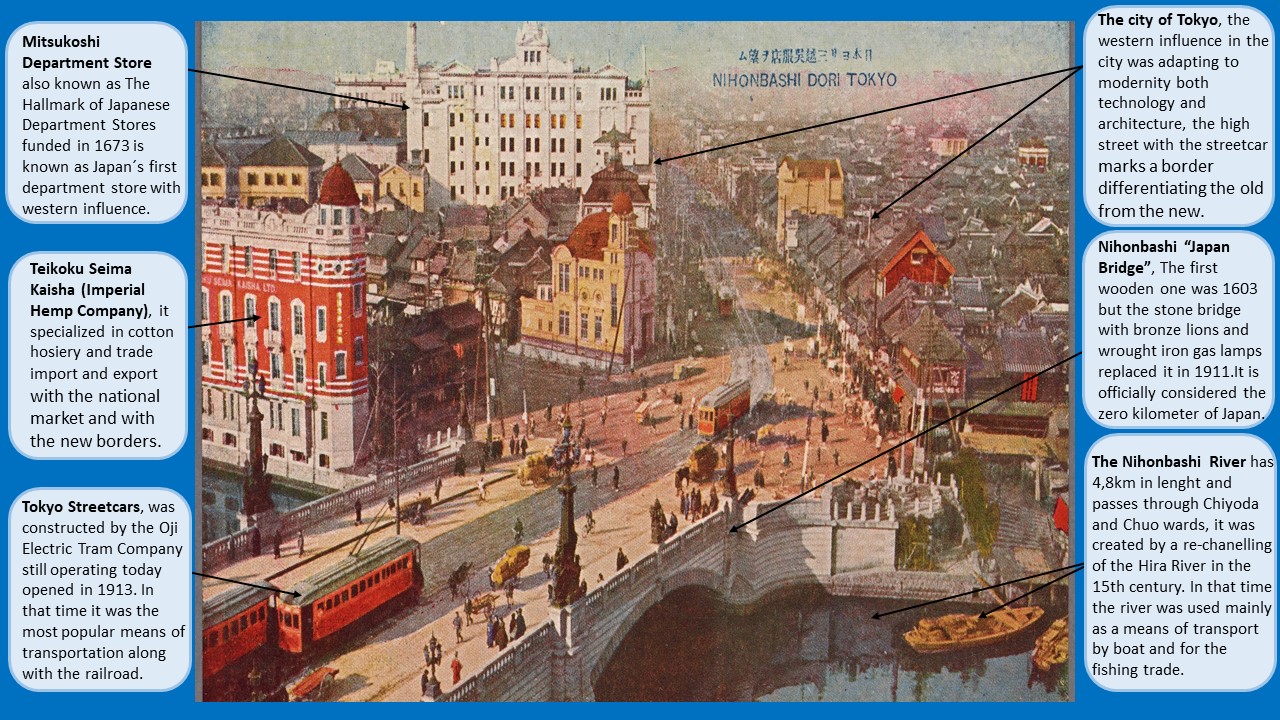TOKYO (1916)
This work of art belongs to a collection of postcards that were made from the city of Tokyo and all the information of the author is unknown. This represents the neighborhood of Nihonbashi in Tokyo around 1916. In this painting we can see a portrait of the neighborhood in its social activity and urban life during the early 20th century. At first glance, we can denote a clear contrast between the modernization that Japan as a country was suffering in one of its most important capitals and, on the other hand, some of the poorest parts of the city which could not keep up with these changes. Therefore, a marked differentiation between the two areas is noticed.
In the early 20th century, between the Meiji government and the Taisho government, throughout the Meiji era (October 23, 1868 – July 30, 1912), Japan changed dramatically. The Japanese government began to open its borders to the rest of the countries abroad, trying to enrich their country, especially with technologies brought from the West. That was appreciated as a great threat as they rather wanted to establish commercial relations with Western countries and remains as an independent as a nation nor a colony. This impelled a huge development in cities as they imported western architects and technicians during the first decades. As a consequences, businesses areas for big companies were established and promoted modernization rapidly. However, the rural zones remained back into tradition, therefore they provided a big contrast.
According to the picture, Tokyo city was divided with a clear distinction between the Western part and the traditional Japanese part. In the center of the image you can see the main street Chuo Dori, which leads to Nihonbashi Bridge. That is one of the main streets of Tokyo that was modernized in that time with means of transport such as streetcars. Tokyo began to adopt a regular morphology in the neighborhoods and streets that were reformed due to external influences, as we can appreciate in the image, while the more traditional areas continued to maintain their irregular urban layout.
Nihonbashi bridge, also known as Japan bridge, is currently the only one next to another bridge of the Meiji era that exists in Tokyo since Edo era (1600-1867). At that time it was made of wood but it was later modernized by the western influence giving it a stone infrastructure to be adorned with gas lamps and some bronze lions. In the image we can see how this bridge was busied with wagons and also one of the first streetcars during the first years of the Taisho Era (July 30, 1912 – December 25, 1926 ). The bridge was designed by Yorinaka Tsumaki (1859–1916), and became very famous because two of the most important routes of the Edo period (Nakasendo and Tokaido) passed through it to connect Edo and Kyoto.
It should be noted that the land on which the city of Tokyo rises has always been very strategic because it was located near the Sumida River. This river circulated along the Nihonbashi district and made it the forerunner of the fish market of Tsukiji. The Nihonbashi district was truly the largest trading center during the Edo Period. The fish market that was created during this period was the current Tsukiji Fish Market, one of the most important fish markets in Japan and the most important in Kanto. This is why Nihonbashi is the point of reference for the Japanese people because all its signals from the highways report the number of kilometers with respect to Nihonbashi, thus making it the zero point of Tokyo. During the Meiji Era, the Nihonbashi River was used for both fishing and transport by boat because this river is a tributary of Kanda River and ends in Sumida River, connecting it to several areas of the city. During the Edo Period this river was also important since the river was created by channeling the old Hira River in the 15th century in direction to Ōta Dōkan in order to form a part of the external fortifications and the water management plan for Edo Castle.
Thanks to Google Maps we can see nowadays how the district of Nihonbashi has expanded along with the city of Tokyo. Today Nihonbashi Bridge is used by the current road of Chuo Dori together with the Shuto Expressway. In addition, the fish market is currently in the Tsukiji area where another fish market was built up due to its position facing the Sumida River which flows into Tokyo Bay.
Juan Bautista Cruz Hernández

